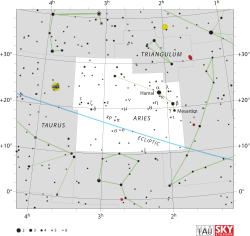56 Arietis, som är stjärnans Flamsteed-beteckning, är en ensam stjärna[10] belägen i den mellersta delen av stjärnbilden Väduren, som också har variabelbeteckningen SX Arietis.[9] Den har en genomsnittlig skenbar magnitud på ca 5,79[2] och är svagt synlig för blotta ögat där ljusföroreningar ej förekommer. Baserat på parallax enligt Gaia Data Release 2 på ca 8,0[1] mas, beräknas den befinna sig på ett avstånd på ca 406 ljusår (ca 124 parsek) från solen. Den rör sig bort från solen med en heliocentrisk radialhastighet av ca 18 km/s.[7]
| 56 Arietis | |
 | |
| Observationsdata Epok: J2000.0 | |
|---|---|
| Stjärnbild | Väduren |
| Rektascension | 03t 12m 14,24595s[1] |
| Deklination | +27° 15′ 25,0931″[1] |
| Skenbar magnitud () | 5,79 (V)[2] (5,75 – 5,81),[3] 5,75 – 5,81 (V)[4] |
| Stjärntyp | |
| Spektraltyp | B6 IV-V[5] |
| U–B | -0,42[2] |
| B–V | -0,106 ± 0,005[6] |
| Variabeltyp | Variabel av SX Arietis-typ (SXARI)[4][3] |
| Astrometri | |
| Radialhastighet () | 18,00[7] km/s |
| Egenrörelse (µ) | RA: 12,035 ± 0,349[1] mas/år Dek.: -18,791 ± 0,271[1] mas/år |
| Parallax () | 8,0413 ± 0,1723[1] |
| Avstånd | 406 ± 9 lå (124 ± 3 pc) |
| Absolut magnitud () | +0,25[8] |
| Detaljer | |
| Massa | 3,16 ± 0,17[8] M☉ |
| Radie | 2,3 ± 0,3[8] R☉ |
| Luminositet | 110[8] L☉ |
| Temperatur | 12 445[8] K |
| Andra beteckningar | |
| SX Arietis, GEN# +1.00019832, PPM 92289, UBV M 9378, GSC 01791-01519, Renson 4910, uvby98 100019832, AG+27 324, HD 19832, SAO 75788, WEB 2874, BD+26 523, HIC 14893, SKY# 4798, YPAC 312, CEL 304, HIP 14893, TD1 1964, YZ 27 1600, GC 3821, HR 954, TYC 1791-1519-1, Gaia DR2 118591610481186688, GCRV 1765, 2MASS J03121424+2715250, UBV 21410[5][9] | |
Egenskaper redigera
56 Arietis är en blå till vit underjättestjärna av spektralklass B6 IV-V,[5] men har också klassificerats som en magnetisk, kemiskt ovanlig stjärna av kiseltyp med en stjärnklassificering av B9 pSi.[11] Den har en massa som är ca 3,2[8] solmassor, en radie som är ca 2,3[8] solradier och utsänder ca 110[8] gånger mera energi än solen från dess fotosfär vid en effektiv temperatur av ca 12 400 K.[8]
56 Arietis är en variabel stjärna av SX Arietis-typ (SXARI),[4] som varierar mellan visuell magnitud +5,75 och 5,81 med en period av 0,727902 dygn eller 17,4696 timmar,[4][12] och som ökar med cirka två sekunder per hundra år.[13] Stjärnan har en femårsperiod för procession av dess axel.[14]
56 Arietis är protypstjärna för SX-variablerna, som är högtemperaturanaloger av Alfa2 Canum Venaticorum-variabler – och uppvisar starka magnetfält och intensiva spektrallinjer av He I- och Si III-.
Se även redigera
Referenser redigera
- Den här artikeln är helt eller delvis baserad på material från engelskspråkiga Wikipedia, 56 Arietis, 22 december 2020.
Noter redigera
- ^ [a b c d e f] Brown, A. G. A.; et al. (Gaia collaboration) (August 2018). "Gaia Data Release 2: Summary of the contents and survey properties". Astronomy & Astrophysics. 616. A1. arXiv:1804.09365. Bibcode:2018A&A...616A...1G. doi:10.1051/0004-6361/201833051. Gaia DR2 record for this source at VizieR.
- ^ [a b c] Nicolet, B. (1978), "Photoelectric photometric Catalogue of homogeneous measurements in the UBV System", Astronomy and Astrophysics Supplement Series, 34: 1–49, Bibcode:1978A&AS...34....1N.
- ^ [a b] Samus, N. N.; et al. (2017), "General Catalogue of Variable Stars", Astronomy Reports, 5.1, 61 (1): 80–88, Bibcode:2017ARep...61...80S, doi:10.1134/S1063772917010085, S2CID 125853869.
- ^ [a b c d] ”SX Ari” (på engelska). The International Variable Star Index. AAVSO – American Association of Variable Star Observers. http://www.aavso.org/vsx/index.php?view=detail.top&oid=3706. Läst 6 maj 2019.
- ^ [a b c] ”Basic data: V* 56 Ari – Variable Star of alpha2 CVn type” (på engelska). Centre de Données astronomiques de Strasbourg. http://simbad.u-strasbg.fr/simbad/sim-basic?Ident=56+Ari&submit=SIMBAD+search. Läst 6 maj 2019.
- ^ van Leeuwen (2007). ”Hipparcos, the New Reduction” (på engelska). http://vizier.u-strasbg.fr/viz-bin/VizieR-5?-out.add=.&-source=I/311/hip2&HIP=14893. Läst 6 maj 2019.
- ^ [a b] Bonsack, Walter K. (February 1958), "Wavelength Variations in the Spectrum of 56 ARIETIS", Publications of the Astronomical Society of the Pacific, 70 (412): 90, Bibcode:1958PASP...70...90B, doi:10.1086/127180
- ^ [a b c d e f g h i] North, P. (June 1998), "Do SI stars undergo any rotational braking?", Astronomy and Astrophysics, 334: 181–187, arXiv:astro-ph/9802286, Bibcode:1998A&A...334..181N.
- ^ [a b] "56 Ari". SIMBAD. Centre de données astronomiques de Strasbourg. Hämtad 2019-07-31.
- ^ Eggleton, P. P.; Tokovinin, A. A. (September 2008), "A catalogue of multiplicity among bright stellar systems", Monthly Notices of the Royal Astronomical Society, 389 (2): 869–879, arXiv:0806.2878, Bibcode:2008MNRAS.389..869E, doi:10.1111/j.1365-2966.2008.13596.x, S2CID 14878976.
- ^ Cowley, A.; et al. (April 1969), "A study of the bright A stars. I. A catalogue of spectral classifications", Astronomical Journal, 74: 375–406, Bibcode:1969AJ.....74..375C, doi:10.1086/110819
- ^ Ziznovsky, J.; et al. (January 2000), "The Variable Light Curve of 56 Arietis", Information Bulletin on Variable Stars, 4835: 1, Bibcode:2000IBVS.4835....1Z.
- ^ Sokolov, N. A. (December 2006), "Ultraviolet variability of the magnetic chemically peculiar star 56 Arietis", Monthly Notices of the Royal Astronomical Society, 373 (2): 666–676, Bibcode:2006MNRAS.373..666S, doi:10.1111/j.1365-2966.2006.11037.x.
- ^ Adelman, Saul J.; Malanushenko, V.; Ryabchikova, T. A.; Savanov, I. (September 2001), "On the rotation of the chemically peculiar magnetic star 56 Arietis", Astronomy and Astrophysics, 375 (3): 982–988, Bibcode:2001A&A...375..982A, doi:10.1051/0004-6361:20010895.



